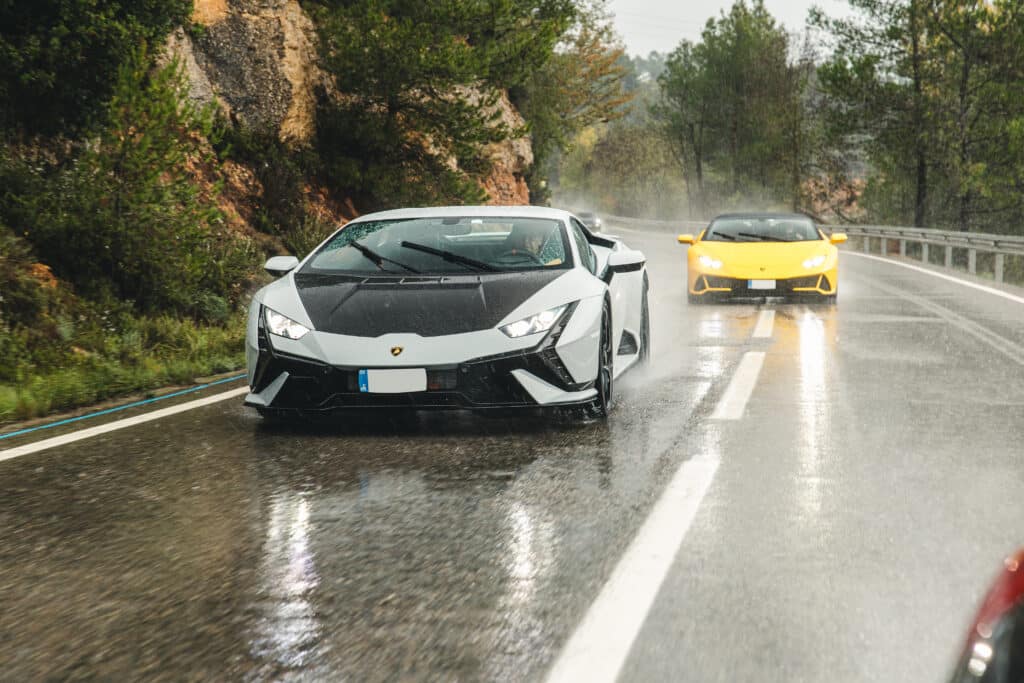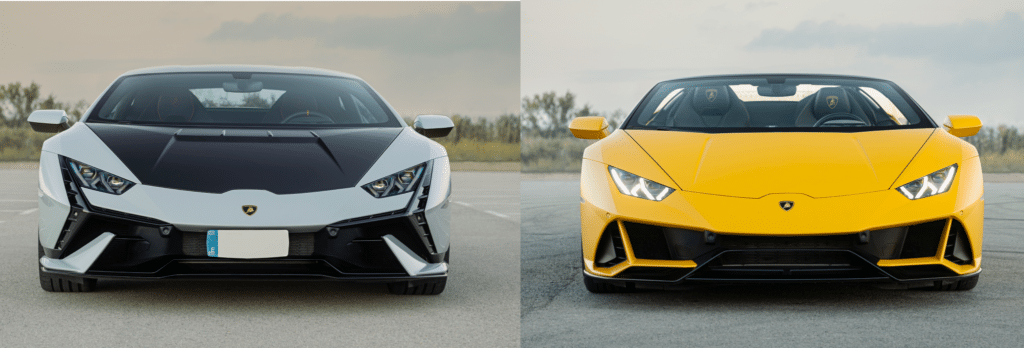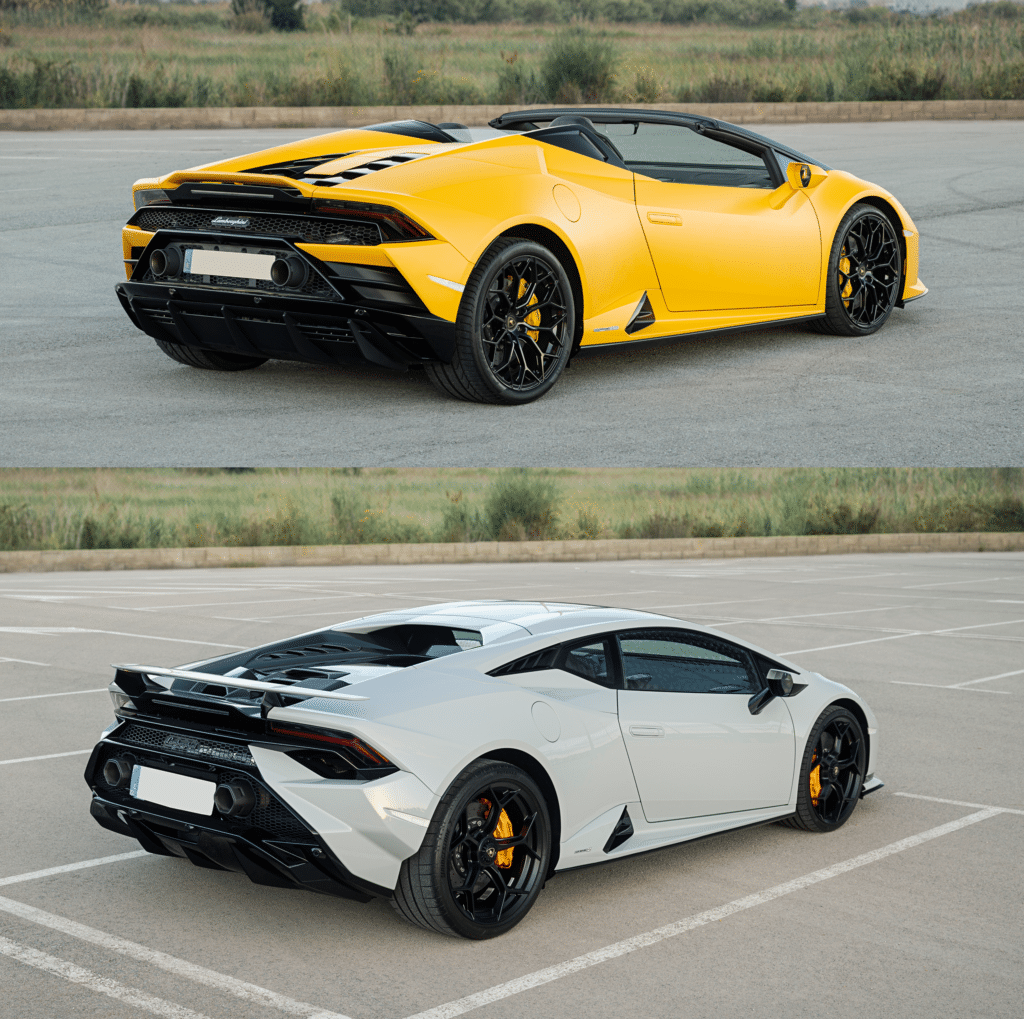Alongside Ferrari, Lamborghini has become one of the most popular and admired supercar brands in the world. Its aggressive design, wide stance, and low profile, almost hugging the ground, create a distinctive silhouette. Even those who aren’t car enthusiasts recognize and admire the bold lines, the deep, thunderous roar of its engines, and that aura of exclusivity and character that makes every model from the brand truly unique.
The Huracan is the most successful model in Lamborghini’s history, with over 20,000 units sold since its launch in 2014. Why? Because it perfectly balances performance, design, and practicality. It’s not as radical or exclusive as the Aventador, Lamborghini’s flagship, nor as geared towards everyday use as the Urus SUV. The Huracan hits that sweet spot: sporty, aggressive, and versatile enough to appeal to a range of drivers.
It’s available in both all-wheel drive and rear-wheel drive configurations, as a coupe or convertible, with track-focused sporty designs or more elegant city-oriented styles, as well as various special editions. This makes it one of the most versatile ranges in the brand’s lineup. The Huracan family includes the elegant Huracan EVO, the dynamic Huracan Tecnica, the track-ready Huracan STO, and the versatile Huracan Sterrato.
In our Drive Me Barcelona fleet, we have both a Lamborghini Huracan EVO Spyder and a Lamborghini Huracan Tecnica. While they share the same core DNA, there are some significant differences in both performance and style. In this article, we’ll break down how they differ and give you a detailed look at the features that make each version unique.
Power and performance
As expected, both the Lamborghini Huracan EVO and the Huracan Tecnica share the iconic 5.2-liter naturally aspirated V10 engine, one of the defining features of the Huracan lineup. Both models produce a maximum output of 640 hp at 8,000 rpm, but they differ slightly in torque: the EVO generates 600 Nm, while the Tecnica delivers 565 Nm, both available at 6,500 rpm. Although this difference might seem small, it directly impacts the acceleration response and dynamic behavior of each model.
However, the most notable difference between the two lies in their drivetrain. While both models use the same 7-speed dual-clutch automatic transmission, the Huracan EVO comes with all-wheel drive (AWD), providing better control and grip in nearly any situation. In contrast, the Huracan Tecnica sends all its power to the rear axle (RWD), resulting in a more purist and direct driving experience. It’s worth mentioning that, in addition to the all-wheel-drive EVO, Lamborghini launched a rear-wheel-drive version in 2020, the Huracan EVO RWD, which maintains the same power and design but offers a more sport-oriented driving experience.
When it comes to performance, the differences are minimal but still notable. The Huracan EVO Spyder accelerates from 0 to 100 km/h in just 3.1 seconds, ahead of the Tecnica, which takes 3.2 seconds, and the EVO RWD, which does it in 3.3 seconds. From 0 to 200 km/h, both the EVO Spyder and the Tecnica record a time of 9.1 seconds, while the EVO RWD takes 9.3 seconds. All three models reach a top speed of 325 km/h, confirming that, despite their slight differences, all offer exceptional performance.
Beyond the numbers, dynamic handling is another area where the Huracan Tecnica stands out. Positioned between the radical approach of the STO and the more refined attitude of the EVO, it features a specific setup with personalized adjustments in the Strada, Sport, and Corsa driving modes. These modes make the most of components such as adaptive suspension, rear-axle steering, torque vectoring, and traction control systems to tailor the car’s character to each situation. The result is a versatile vehicle, capable of offering comfort on the road and maximum precision on the track.

Two opposing designs: elegance in the EVO, sportiness in the Tecnica
The bodywork and aerodynamics are undoubtedly the most visible elements that set the two versions apart.
Starting with the front end, the Lamborghini Huracan Tecnica has undergone a complete redesign compared to the EVO. While the EVO retains a design more faithful to the traditional Huracan aesthetic, with a wide and angular look dominated by two large side air intakes, the Tecnica breaks away from that mold. It adopts a completely different identity: far more aggressive and aerodynamically focused, featuring sharper lines and more defined shapes.
Its front bumper features a new “Ypsilon” design, with Y-shaped slats that extend from each headlight. This innovation is inspired by the Terzo Millennio hypercar prototype and has also been adopted by other models like the Sián FKP 37 and the Revuelto. But this is not just an aesthetic change: this design introduces air curtains for the first time in a Huracan, improving aerodynamic efficiency along the sides. It also comes with a new front splitter, which balances the front aerodynamic load and channels air toward the brakes, as well as a hood made entirely of carbon fiber.

The changes continue along the profile and rear of the Huracan Tecnica. The side windows and upper air intakes have been modified to resemble the Essenza SCV12 competition prototype. The new vertical rear window improves visibility, while the rear hatch, made from carbon fiber, incorporates vents that help release heat from the V10 engine, which is partially visible.
At the rear, the Tecnica introduces a fixed rear spoiler, as well as a new model-specific rear bumper with a larger air intake that improves hot air evacuation and reduces turbulence. Completing the redesign, the exhaust pipes take on a hexagonal shape instead of the traditional circular exits of the EVO, further emphasizing its aggressive identity.

However, where the Tecnica’s redesign truly makes a difference compared to the EVO is in aerodynamic performance: the addition of a fixed rear wing increases rear downforce by 35% while simultaneously reducing aerodynamic drag by 20%. This results in enhanced high-speed stability and more responsive, precise handling.
An interior with no significant changes
The interior of both models maintains Lamborghini’s classic design, with no major structural changes but impeccable execution that stands out for the quality of its finishes. The entire cabin is upholstered in Alcantara, evoking luxury and sportiness in every detail.
At the center of the console is the now-iconic 8.4-inch vertical touchscreen, which manages the vehicle’s main functions and infotainment system. Just below it, the characteristic red flip cover that conceals the ignition button becomes the true focal point of the cabin.
The multifunction steering wheel provides direct access to key controls, while the digital instrument cluster, located just behind, offers a clear, driver-focused interface. In the Huracan Tecnica, this panel adopts a more minimalist design, with a more defined arch and fewer colors, improving readability.
Both models feature a complete connectivity system, compatible with Apple CarPlay, Android Auto, voice control via Amazon Alexa, and navigation through What3Words.

Weight and dimensions
In terms of size, the Huracan Tecnica is 4,7 centimeters longer than the Huracan EVO, measuring 4,567 mm compared to the EVO’s 4520 mm. At first glance, especially from the side, it’s hard to notice, although the Tecnica visually appears lower and wider. However, both models share exactly the same width (including mirrors): 2236 mm. As for height, the difference is minimal: the EVO stands at 1180 mm, while the Tecnica sits just slightly lower at 1165 mm.
Where we do see a more noticeable difference is in weight. Thanks to the extensive use of carbon fiber throughout its bodywork, the Tecnica achieves a dry weight of 1379 kg, 43 kg lighter than the EVO, which weighs 1422 kg. In the case of the EVO Spyder, the soft-top roof adds extra weight, bringing it up to 1442 kg, creating a 63 kg difference compared to the Tecnica.
These figures are reflected in the power-to-weight ratio, where the Tecnica comes out ahead with 2,15 kg/HP, compared to 2,22 kg/HP for the EVO and 2,40 kg/HP for the EVO Spyder.
Final verdict
After going over the main differences between the Lamborghini Huracán EVO and the Lamborghini Huracán Tecnica, it’s clear that both models deliver exceptional performance and driving dynamics. While they share the same mechanical foundation, they embody two distinct philosophies within the Huracan lineup: the EVO presents a more elegant and balanced approach, ideal for those looking for a stylish, comfortable, and versatile supercar. The Tecnica, on the other hand, is built for those who want to push boundaries, with a sportier character, a more aggressive design, and a setup tuned to unleash its full potential on the track.
Ultimately, the best way to find out which one suits you best is by getting behind the wheel. The choice between the two comes down to personal preference and the kind of thrill you’re after: do you want a refined and stylish supercar, or one with the heart and soul of a track machine?
At Drive Me Barcelona, you have the chance to drive both and decide for yourself which one fits you best.
Want to experience the Lamborghini Huracan EVO Spyder? Check its availability here.
Prefer to take the wheel of the Lamborghini Huracán Tecnica? Check its availability here.





